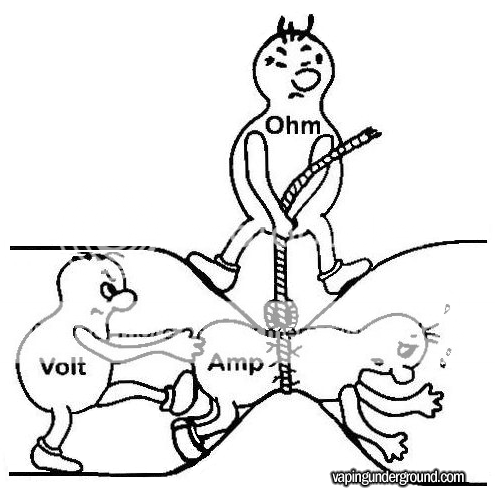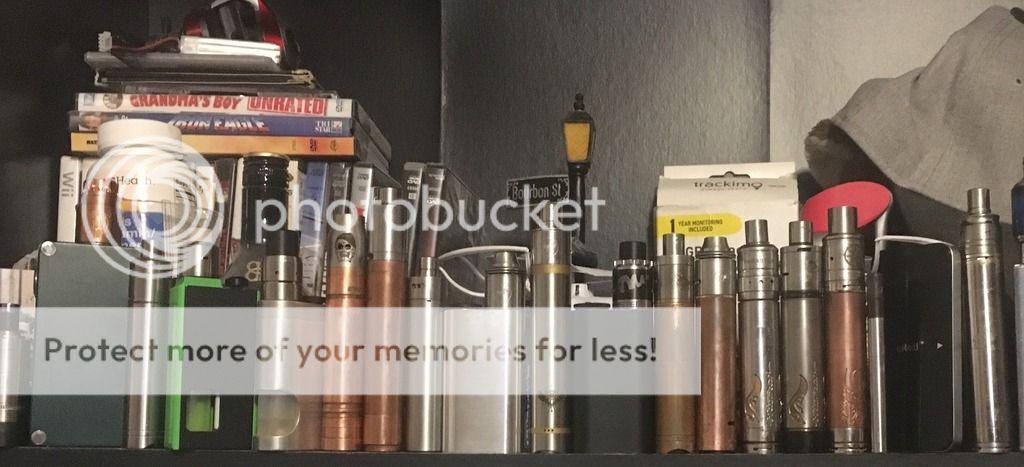Wow thanks guys that was fast! Ok so here's where I get confused. The vape store owner said that if I vape ABOVE the ohms of whatever coil I'm using (.4 or .2), it will burn my cotton up right away, but if I vape BELOW the ohms of whatever coil I'm using (.4 or .2) I could explode the battery.
JuicyLucy: They vape at 1.8, but on WHAT kind of coil? I don't get it! I guess my main question is this: if I use a .4 coil, what's the HIGHEST ohms I can vape at without burning the cotton, or the LOWEST ohms I can vape at without exploding the battery? Or am I totally asking the wrong question?! Haha
mattdarat & f1reb1rd : I don't believe I have a connection issue, nor did I mention it. Why are you talking about that? Sorry to single you out (I greatly appreciate your responses), but you're hardly the first to answer a question I DIDN'T ask. This is why I get confused, I search for information on an issue and people start talking about another issue entirely and do not explain why the f*** they are talking about that issue. This trend is rampant in the vape world, I'm noticing. Can you be more clear? What specs should I check? I've been over them multiple times, I know the specs, I do not know what ohms are safe to vape at nor can I find a friggen clear answer!
Thanks for your responses everyone! My angry tone is not directed at you, more so at my brain not grasping these concepts properly!
For one VOLTAGE will not help create formaldehyde.
Whoever told you that does not know what they are talking about.
The formaldehyde study has been debunked more times than I could mention
Voltage is a unit of measurement. The formaldehyde was produced using a wicking material rarely used these days and applying such a high amount of power to it, that no one would be able to vape it.
Why did we mention connection? Because it could be a reason for your resistance changing.
What ohms are safe to fire?
That depends on mod, mode and battery. Juicy gave you a good answer for the coils you are using.
If you want to know more about what we are talking about:
Terminology used in Vaping
Ok, im pretty sure that if you’ve gotten to this point you have a basic idea on what some of the vaping terms and acronyms. But let’s get these out of the way.
Watts- a unit of measurement in electronics to indicate applied power
Volts- a unit of measurement in electronics to indicate pressure applied to current to create power
Resistance- a unit of measurement in electronics to indicate resistance
amperage- a unit of measurement in electronics to indicate current flow
The above four will be discussed more in a later section
Atomizer- this is the top part of the vaporizer, which heats the liquid and converts it to vapor
Subohm tank- this is a type of atomizer with tank and changeable coil with a resitance below one ohm
Clearo – or – clearomizer - a type of atomizer consisting of a tank and changeable coil with a resistance above 1 ohm
RBA – an atomizer that is designed to be rebuilt by the user. These allow the user to fine tune a vape the way they like.
RDA- a type of RBA where the user drips juice directly onto the coil, there is no tank. These are very common and tend to be geared towards either flavor or a lot of vapor production.
RDTA is a type of rda with a tank attached
Gensis style- a modular rda with a tank below the atomizer and a wick pulling juice to the coil
RTA- an RBA with a tank attached and the uice usually flowing from below the rebuilt coil via a vaccum pressure. Like a subohm tank but with col rebuilt by the user.
MOD- the portion of the vaporizer with the batteries. This is a broad term used for any handheld battery operated device that fires the atomizer.
Mech- this is short for mechanical mod, a device that holds a battery with battery contacts. There are not any safety features incorporated in a mechanical mod. Usually they are single battery tubes, or dual battery boxes in series or parallel. These should only be used by experienced vapors with a basic understanding of electronics theory, safety, ohms law, coulombs law, and those who know what they are doing.
Unregulated mod- similar to a mechanical mod but has wires and usually a mosfet switch. But the same principals for safety apply. – you
are the safety feature.
Regulated mod- these have become the most popular mods in vaping. They come in several different shapes sizes and features. Essentially they have a battery, and circuit board as well as a way for you to adjust voltage or wattage. Some allow you to regulate temperature to a degree as well (more on that later), they usually have safety features and vary in there complexity, from a dial to push button. Some safety features would be current and voltage limits, reverse battery protection, and not allowing you to fire unsafe coils. Still I stress-
ultimately you are responsible for your own safety. All electronics have the prepotency for failure.
TCstands for temperature control. This allows you to set a limit not allowing the coil to go over a predetermined temperature.
PWM- Pulse Width Modulation, this is a way of applying power to the coil that modulates the power by firings in pulse. This is not used frequently anymore but you still may hear the term from time to time. It is usually accompanied by a rattlesnake sound.
Batt- common term for battery
510- the connection used on the mod to connect it to the atomizer. The female side is on top of the mod with the male side on the bottom of the atomizer.
DripTip- the mouth piece on the atomizer
Chuff cap- the wide more driptop that takes the place of the driptip
Ok, im pretty sure that if you’ve gotten to this point you have a basic idea on what some of the vaping terms and acronyms. But let’s get these out of the way.
Watts- a unit of measurement in electronics to indicate applied power
Volts- a unit of measurement in electronics to indicate pressure applied to current to create power
Resistance- a unit of measurement in electronics to indicate resistance
amperage- a unit of measurement in electronics to indicate current flow
Ohms Law
I have written about ohms law more times than I care to say, however, I am going to try my best to simplify this as much as possible.
Think of a circuit as a hose. The water flowing through the hose is the electricity or current(amps). The pressure pushing the water is the voltage. Now pinch the hose. Pinching the hose is adding Resistance. The pressure building up is voltage and the current flow has now decreased because you applied resistance.
Now if you take that Voltage or pressure and Multiply it by the Current or Amperage you are given your power or wattage measurement.
The problem comes in when you have a 20a battery but are trying to force it to give you more current than it has to offer.
All 4 parts that make a circuit happen are happening in conjunction with each other and as an added note to the beauty of it, whatever energy is put in must be equal to the energy coming out. What this means is that all you need are two bits of information to determine the others.
Ohms law is basically the relation of those bits of information. If you multiply the resistance applied by the current you are then given your voltage or force applied.
For ease of use the forumulas are
V=IR and P=VI
when:
V= voltage
I=current (amps)
P=power (watts)
R= resistance(ohms)
Why does ohms law matter? Batteries!
Why do you see some of us harp on ohms law? Because batteries. A battery is a limited space to hold energy. This means that we have to work within our limits. You don’t want to overdraw on your batteries. If you do bad things can happen, such as venting a battery or causing a battery to explode.
a better ohms law explanation
Ohm's Law - The basics - Ohms Law Formulas Explained to save you time
When choosing a battery for your mod it is important to make sure that the battery can handle the current that you are pulling from the battery. Also ensure you know the limitations of your mod per the manufacturer.
Using ohms law you can easily determine the current draw. Please see the threads authored by baditude, here in the battery section; or, myself in the beginner area.
ohms law-V = I x R Or I = V/R when I=current(amps), V=voltage, R=resistance(ohms)
So, if I need the current for a battery- I am assuming the battery at mean voltage therefore it is at 3.7v. and I am firing a 0.5 ohm resistance. Those are my two constants for the same of our math.
I would use the following as my equation:
I = 3.7v/0.5ohms
in this case I am only pulling 7.4A and 27.4 w; therefore, I want s battery that is capable of providing 7.4A safely.
admittingly, as the chart shows, most batteries can handle this. problems ome into play when people fire to far low.
NOW, lets try this with a 0.2 ohm load (coil), the voltage is the same here.
I=3.7v/0.5ohms
in this case we have 18.5amps and 68.45 w. Therefore, it is easily illustrated that the field of suitable batteries, has greatly been reduced to cells that can handle a continuous current of 20A.




